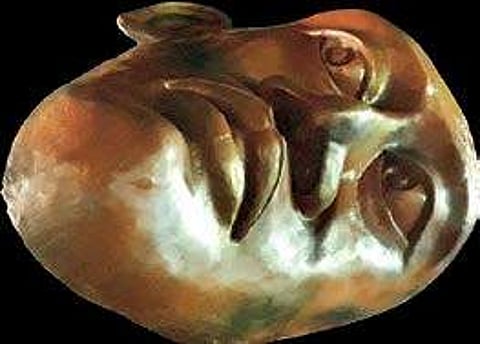

THIRUVANANTHAPURAM: ‘Ana Arabi’ booms Mahmoud Darwish’s plaintive voice, spiked by a slew of sounds. In front hangs a naked man upside down, nails piercing his face and torso. It’s poetry seething with protest, anguish and anger oozing through every pore of it. ‘I am an Arab, a name without any title. Patient in a country where everything lives in a whirlpool of anger’, reads the poem, lines that tenaciously capture the agony of alienation.
As Darwish’s Identity Card, an anthem of Palestinian exile, rains down the speakers in Malayalam, you get transported to his ravaged homeland.
Punctuating Bijibal’s rendition are sounds that complement the verse - you catch the familiar strains of namaz and flinch at whips slicing through the air. In the koothambalam at Vyloppilli Samskriti Bhavan the poem comes alive in all its poignant glory, backed by a brilliant audio-visual interpretation at the ongoing poetry installation. “We see it as a political art, something that addresses a social cause,” says writer and filmmaker Vinod Krishna, who conceived the novel art form.
The soundscape
Creating a 3D art from a piece of poetry and blending it with a spectrum of sounds can be tricky in more ways than one. “I have tried to interpret the poems through a merger of sounds. Sachidanandan’s Yuddam Kazhinju has been conceived as a segment documenting the history of war staring with the sound of conch. Then there are metals and horses progressing towards guns and canons,” says award-winning sound designer Renganaath Ravee. Some sounds were specially designed for the project while others were taken from various archives.
“We recorded the sound of a river in Ladakh for authenticity, then there are distinctive bird chirps of the place. We used the sounds of different valley birds in Kargil including Himalayan woodpecker, a bird that lives in total harmony with its ecosystem. It represents the pacifist voice.”
He says the more challenging poem was Amrita Pritam’s My Address which is a blend of so many emotions. “The sounds of protest, people knocking at doors and finally the sound of pigeons taking flight were used to convey subjugation and freedom,” he adds.
In Neruda’s poem he uses underwater sounds to mark the depth and solitude of ocean along with ship horns. “Though people are quite appreciative I feel the soundscape of Identity Card is somewhat incomplete. While all other poems are recited with breaks, this one just flows and weaving apt sounds into it was a real task. I scoured through Arab films and documentaries for this,” adds Ravee.
An all-new art
A man sits with his face buried in his knees, just like a heap of salt, on a spoon. The lines of Pablo Neruda’s ‘Ode to Salt’ starts filling the air and you suddenly find an all-new dimension to the familiar lines. ‘I shivered in those solitudes/when I heard/the voice of the salt/in the desert.’ “Neruda calls salt the dust of the sea, something that defines ocean’s existence. We all know about his love sonnets, but he has also penned poems that explore other motifs.
A man losing his salt or a nation losing its soul is a very serious thematic concern,” he adds. There are three translations by K Sachidanandan - Uppinoru Sthuthigeetham (Pablo Neruda), Identity Card (Mahmoud Darwish), and Ente Melvilasam (Amrita Pritam). Yudham Kazhinju is written by Sachidanandan and is rendered by Ajish Dasan. Actor Joy Mathew gives voice to Neruda while it’s Bijibal and Sayanora for Darwish and Amrita Pritam.
Vinod says the concept stemmed from a poem, written by his friend. “In the poem a horse declares itself as the national animal. Though he is an established poet nobody was willing to publish it. Intrigued by the blatant dismissal I decided to present it in a novel style and that’s how we did our first poetry installation. It’s our third edition,” says Vinod. The project was conceptualised by a five-member team involving Vinod, Renganaath Ravee, Linu Chakrapani, G S Vinayan, Raveendranath and Dhanya K Vilayil.
Visual version
Door frames are erected around a woman whose face is replaced by a postbox in My Address. “I have used transparent fiber for this. More than feminine she looks strong and sturdy, representing a bold mind,” says art director Linu.
According to him, the images evolved out of multiple readings of and group discussions. “Identity Card is an angry wail of the Arabs uprooted from their homeland. The Arab in the poem says they have taken away his ancestor’s vineyards leaving behind just rock. As a sculptor I felt the most important aspect was the tyranny involved, something I tried to communicated through the rope and nails,” he says.
A whole armoury, from the primitive ax to the most-sophisticated firearms, jets out of the face in Yuddham Kazhinju. “It shows warmongers masquerading as good Samaritans. It’s an image I derived from Kurukshetra war in the poem,” he says. the poetry installation is on till May 20.